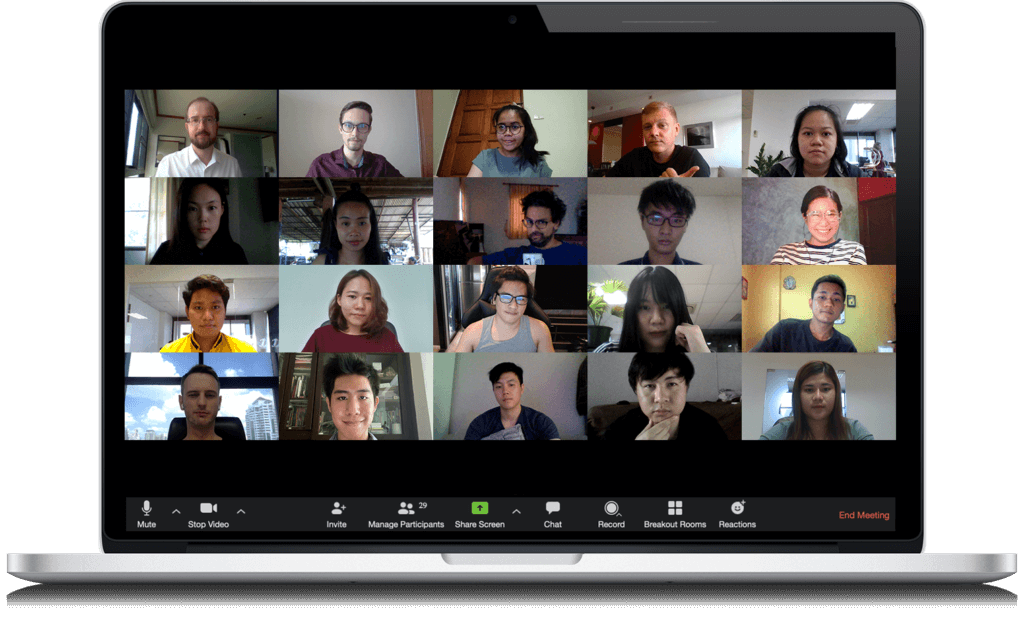When the outbreak of COVID 19 started in early 2020 in Thailand, a confinement wasn’t strictly asked by the Thai government, but most office companies in Bangkok decided to work from home and we did too at Outsourcify to safeguard the health and safety of our employees was our top priority. It was unfortunate as we had just moved to a new office, and also because we are proud to be a cohesive team working together in our office and we actually never work with outside consultants or freelances, so despite working on online projects we weren’t used to work apart from each other geographically.

The challenge to switch to remote work.
It was a challenge to suddenly decide to work from home, especially as the decision was taken very quickly.
Fortunately our industry implies working on computers and everyone in the team works on a laptop computer so it was possible to work from home, many in the team even also took home their monitor in order to have the same workstation available.
The change was more obvious in trend of every day work organisation and communication. We were already using online communication tools, often chatting with co-workers just a distance from us, but never in such a scale. Our office is an open space but it’s separated in different areas by team : administration, design, mobile development, web app development, WordPress dev, elearning team etc. This helps the communicating inside each team, teams are also working with each other and are their members are quite fluid dependent on the projects currently worked on.
Each team often has internal meetings in our meeting room, we also frequently do standup meetings to learn the current progress of every team member that works on a project tasks, align team members around company goals and let them address any short-term challenges that prevent team members from effectively performing their sprint tasks.
Suddenly all of these were not possible anymore and we had to come up with alternative solutions.
We totally spent 2 months working from home, relying on chat and video calls, and we only returned to work when Thailand started to keep the coronavirus infections low and it didn’t seem needed anymore.
At first, we tried to figure out how to stay and focus on tasks productively while we were working from home. In this article, we’d like to share how we managed tasks and communication with the team and clients effectively during this crisis and our current situation after coming back to work.
Solutions for working from home
The key concerns were to follow up with what everybody was doing and to keep clear communication with colleagues and clients and knowing exactly what they wanted. Here are the ways we counteracted against lack of information and control and miscommunication.
Tracking work done
In the first days, we enforced the use of an app which was tracking the daily computer use, checking actions on the keyboard and mouse, even taking screenshots regularly. This was borderline spying and eventually didn’t prove to bring any benefits as anyway each employee is followed up through the fact we work on small teams and affect clear tasks through project management tools. It didn’t make sense to check the stats from this app, it didn’t bring valuable insights on the work done, just stats on the presence in front of the computer.
We abandoned this app after a few weeks, and only sticked to a spreadsheet with a daily tab where everybody would note the time they started and finished, and the current project, tasks and objectives for the day.
Efficient communcation
Online communication tools helped bring our team together while we were working from home in distant locations. For an efficient and smooth communication with the team and clients, we used different technology applications each suitable for specific situations. To find out more information about the applications we used, check this article https://outsourcify.net/working-remotely/.
The presence and status spreadsheet just mentioned above was simply shared on Lark which is the chat tool we use at Outsourcify, it’s a free Slack clone which also has its own set of desktop tools. Our HR was in charge of reminding anyone who forgot to fill it up and tracked the absences and holidays taken as usual.
Internal Communication:
Lark, Teamwork and Google drive
External communication with clients:
Skype, Zoom, Hangouts, BlueJeans, Slack and Emails.
Managing meetings:
There were more of meetings planned than before in real interactions in the office. To manage the meeting schedule, we used the calendar integrated in Google Workspace (formerly Gsuite).
Concentrating while working from home
One of the hardest things of working remotely is focusing on tasks without getting influenced by our surroundings. This can be especially tedious with kids having to stay at home too.
Additional project management was definitely needed. We assigned specific tasks to our analysts, designers and developers through the Teamwork project management SaaS platform with deadlines as we usually did, but tried to be more detailed in the description of each task. The tracking of tasks requires more time then. To respond to this concern and complete the tasks on time, we had 2 times-morning and afternoon- in a day to track where we were through video call face-to-face and voice interactions.
Morning Check:
We conducted a morning check within 10min from 10a.m to give a brief and discuss the tasks of the day.
Afternoon Check:
In the late afternoon, we conducted a progress check and track of lots of moving parts depending on projects for about an hour.
Communication challenges
The pandemic has forced the adoption of new ways of working especially about communication. We couldn’t be person-to-person with our team and customers. We could clearly see how the pandemic changed our communication.
First of all, much more phone and video calls were made with team members as with clients as obviously no direct interactions in our office and especially in our meeting room were possible. Furthermore, it seemed to take more time than before writing messages to deliver what we wanted to convey to team members and clients clearly. This change required us more time and patience to communicate with each other. To solve this problem, we tried to limit the calls to a specific amount of time depending on the subject of calls.
Secondly, We found out during this time working remotely that it was harder than usual to stay motivated and to address the stress of the situation when urgent deadlines were to be met, like a sense of lost of time and sometimes of purpose.
Thirdly, support such as advice, direct questions and answers from colleagues was harder to get. This situation created losses of time sometimes. As we mentioned above, because of limited direct access to each other in the team, mostly communicating through calls and chats in the virtual world required us more time and patience. It was surely challenging to us
Returning to work
After spending weeks in quarantine, we returned to work. We found some changes in our work performance, communication and environment, and these 2 months working at home did also let us to improve some parts of our work process.
Firstly, the productivity of communication had improved even though we still use the same tools as when we were working remotely. We try to keep a quieter environment space by using more written communication to improve efficiency of work for all team members.
Secondly, productivity and motivation have been boosted with less distractions around and availability of direct advice with each other. We feel more connected and enjoy interactions with team members.
Lastly, there has been a change in meeting with clients. During the COVID-19 pandemic, we had to replace person-to-person meetings with video conferences due to social distancing and working remotely. After returning to work, we found many clients were fond of having a meeting through video conference and we realized that it offers many advantages. Here is the list of advantages we found.
- Travel to attend the meeting in person interactions can consume time and budget. Video conferencing helps to save time. In addition, it can benefit the ability to connect seamlessly with customers situated in different time zones and helps us structure the day better.
- When we have a video call with clients, we set up the time limit (30min max for example). It helps to improve the efficiency of the meeting.
- Workshops have been held online with useful SaaS tools. Same as with the video call, we set up a time limit (2h max usually) and it is more efficient and helps us to get outcomes without disruption.
Conclusion
Overall, full-time working from home for 2 months would have been economically and personally painful. Nevertheless, we learnt that working remotely was still efficient and taught us how to actually be more flexible in our working processes. In addition, it was a kind of opportunity to see how remote work can affect our working performance and we found that our field allows us to work from home if it is necessary without losing in productivity.















